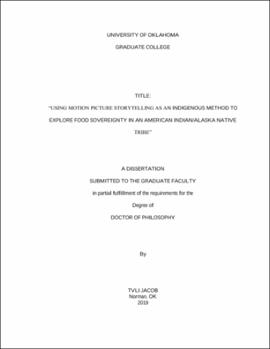| dc.description.abstract | For many American Indian/Alaska Native (AI/AN) communities, food is important, not only for basic health reasons, but cultural, traditional and spiritual as well. The concepts of food sovereignty have various definitions, from political to healthful (Claeys, 2013; Whitman, 2010; Grassroots International, 2018; Declaration of Nyéléni, 2007). Though we understand what food sovereignty is in a general concept, in order to understand food sovereignty at a local level, it may be necessary to gather knowledge from members of an AI/AN community. To best gain that knowledge is to use Indigenous research, which is a method in which researchers Indigenize the process of common western theory, such as understanding the local phenomenon and understanding the Indigenous community from whom we interact and learn. Since each community’s perceptions will be different from tribe to tribe and community to community, it would be necessary to have community members share their perspectives on what food sovereignty means to them and share the knowledge that a researcher would not obtain otherwise.
The concept of motion picture storytelling was used to collect qualitative data from 5 AI/AN community members to share their knowledge, experience, thoughts, beliefs and ideas on food sovereignty through story. Using indigenous methods of research, the tribal citizens had complete control in how they shared their motion picture stories through the moving images, dialogue, discussions or any other means they wish to use to share their concepts of food sovereignty and how it relates to them, their family, and their community. Findings showed that culture, tradition, and community is an important factor to food sovereignty on an individual/community level. The five themes discovered were land, health, culture/tradition, the tribes farm, and ceremonial dance. The stories also revealed that the stories are strong in this AI/AN community and the storytellers were active participants and embraced the sharing of their stories. | en_US |
